The femtosecond optical parametric oscillator market is projected to expand from USD 261.1 million in 2025 to USD 754.9 million by 2035, marking an absolute increase of USD 493.8 million. This translates into total growth of 189.1% at a CAGR of 11.3% during the forecast period. The femtosecond optical parametric oscillator market is expected to grow by nearly 2.9X in this timeframe, reflecting its central role in advancing ultrafast photonics and laser-based applications.
Between 2025 and 2030, the femtosecond optical parametric oscillator market is forecast to increase by USD 173.7 million, reaching USD 434.8 million and contributing 35% of the decade’s growth. This phase will be heavily driven by the adoption of wavelength-tunable femtosecond systems in research laboratories and industrial facilities. Their ability to generate ultrashort optical pulses with exceptional stability positions them as indispensable tools for spectroscopy, biomedical imaging, and nonlinear optics. Institutions focused on advanced materials science and life sciences research will particularly fuel demand, as enhanced spectral tuning and superior ultrafast timing become baseline requirements.
From 2030 to 2035, the femtosecond optical parametric oscillator market is expected to add USD 320.1 million in value, accounting for 65% of overall expansion, and reaching USD 754.9 million. This growth surge will be shaped by the widespread penetration of femtosecond oscillators into spectroscopy platforms, high-precision measurement systems, and industrial micromachining operations. Photonics players are anticipated to integrate these oscillators with comprehensive ultrafast laser architectures to deliver higher flexibility and efficiency. In parallel, semiconductor and microelectronics manufacturers will increasingly rely on ultrafast optical systems for defect detection and precision material processing, ensuring broader industrial uptake.
Geographically, North America and Europe will remain at the forefront, benefiting from well-established photonics ecosystems and government-backed research initiatives. Asia-Pacific is expected to experience accelerated adoption, supported by rising investment in optics and laser research, as well as expanding semiconductor and electronics industries in China, Japan, and South Korea. The Middle East and Latin America will likely participate gradually, focusing on specialized research applications and niche photonics integration.
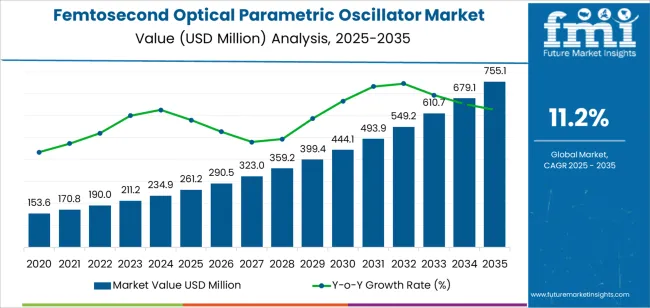
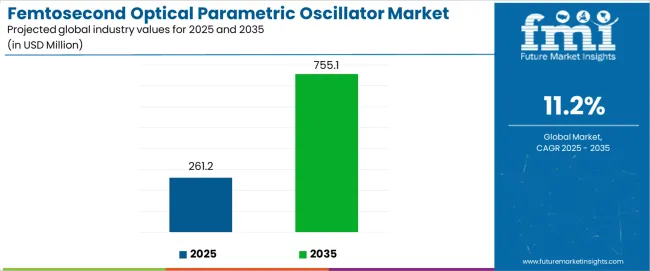
| Period | Primary Revenue Buckets | Share | Notes |
|---|---|---|---|
| Today | Wavelength tunable systems | 62% | Advanced spectroscopy, research applications |
| Wide spectrum output systems | 28% | Multi-wavelength platforms, broadband applications | |
| Fixed wavelength systems | 10% | Specialized applications, industrial processing | |
| Future (3-5 yrs) | Advanced tunable platforms | 55-58% | Enhanced wavelength coverage, automated control |
| High-power wide spectrum systems | 22-25% | Industrial processing, materials research | |
| Nonlinear optics applications | 8-12% | Frequency conversion, harmonic generation | |
| Raman spectroscopy systems | 6-10% | Chemical analysis, biological research | |
| Lidar and remote sensing | 4-8% | Atmospheric monitoring, defense applications | |
| Custom and specialty solutions | 3-6% | Research-specific configurations, unique applications |
At-a-Glance Metrics
| Metric | Value |
|---|---|
| Market Value (2025) | USD 261.1 million |
| Market Forecast (2035) | USD 754.9 million |
| Growth Rate | 11.2% CAGR |
| Leading Output Type | Wavelength Tunable Output |
| Primary Application | Nonlinear Optics Segment |
The femtosecond optical parametric oscillator market demonstrates strong fundamentals with wavelength-tunable systems capturing a dominant share through advanced spectral properties and research application optimization. Nonlinear optics applications drive primary demand, supported by increasing precision requirements and photonics industry modernization initiatives. Geographic expansion remains concentrated in developed markets with established research infrastructure, while emerging economies show accelerating adoption rates driven by scientific research modernization initiatives and rising technology standards.
Design for research precision, not just output power
Laboratory integration readiness
Quality-by-design approach
Value-based pricing models
Primary Classification: The market segments by output type into wavelength tunable, wide spectrum, and others, representing the evolution from fixed wavelength sources to sophisticated tunable platforms for comprehensive ultrafast optical optimization.
Secondary Classification: Application segmentation divides the market into nonlinear optics, Raman spectroscopy, lidar, and others, reflecting distinct requirements for spectral performance, pulse characteristics, and precision measurement specifications.
Tertiary Classification: End-use segmentation covers research institutions, industrial facilities, defense contractors, medical centers, and educational establishments, while distribution channels span direct sales, scientific distributors, and specialized photonics suppliers.
Regional Classification: Geographic distribution covers North America, Latin America, Western Europe, Eastern Europe, East Asia, South Asia Pacific, and Middle East & Africa, with developed markets leading adoption while emerging economies show accelerating growth patterns driven by research infrastructure modernization programs.
The segmentation structure reveals output progression from traditional fixed wavelength systems toward sophisticated tunable platforms with enhanced spectral capabilities, while application diversity spans from fundamental research to industrial processing requiring precision optical solutions.
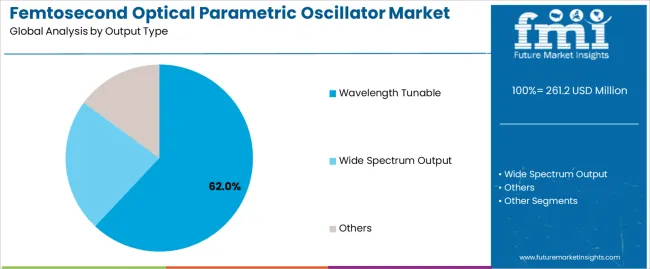
Market Position: Wavelength tunable systems command the leading position in the femtosecond optical parametric oscillator market with 62% market share through proven spectral technologies, including broad wavelength coverage, precise tuning capabilities, and research optimization features that enable scientific operators to achieve optimal experimental outcomes across diverse laboratory and industrial environments.
Value Drivers: The segment benefits from research industry preference for flexible laser systems that provide broad spectral coverage, precise wavelength control, and operational versatility without requiring multiple fixed-wavelength infrastructure. Advanced tuning mechanisms enable enhanced spectral resolution, rapid wavelength scanning, and integration with existing research programs, where spectral flexibility and measurement precision represent critical operational requirements.
Competitive Advantages: Wavelength tunable systems differentiate through proven spectral reliability, comprehensive wavelength coverage, and integration with established research platforms that enhance facility effectiveness while maintaining optimal precision standards suitable for diverse scientific applications.
Key market characteristics:
Wide Spectrum Shows Versatility Market Position
Wide spectrum output systems maintain a 28% market position in the femtosecond optical parametric oscillator market due to their broadband advantages and multi-application positioning benefits. These systems appeal to facilities requiring comprehensive spectral coverage with enhanced bandwidth profiles for simultaneous multi-wavelength operations. Market growth is driven by industrial research expansion, emphasizing broadband optical solutions and operational efficiency through optimized spectral designs.
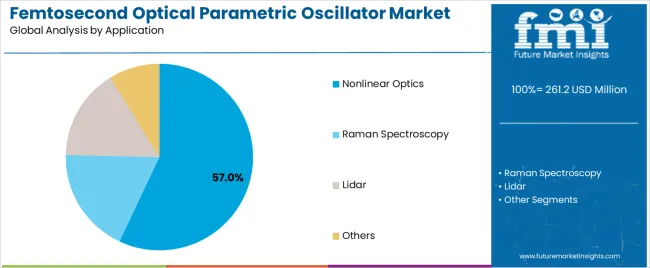
Market Context:Nonlinear optics applications demonstrate strong growth in the femtosecond optical parametric oscillator market, accounting for 57% of the share. This growth is driven by the widespread adoption of frequency conversion systems and an increasing focus on advanced optical processes, operational precision, and spectral manipulation, all of which enhance laser effectiveness while maintaining research standards.
Appeal Factors: Nonlinear optics operators prioritize system reliability, spectral consistency, and integration with existing research infrastructure that enables coordinated optical operations across multiple experimental setups. The segment benefits from substantial photonics industry investment and modernization programs that emphasize the acquisition of advanced laser systems for frequency conversion and harmonic generation applications.
Growth Drivers: Nonlinear optics expansion programs incorporate femtosecond oscillators as essential components for frequency conversion operations, while advanced research growth increases demand for laser capabilities that comply with precision standards and minimize experimental complexity.
Market Challenges: Varying research requirements and experimental complexity may limit system standardization across different laboratories or measurement scenarios.
Application dynamics include:
Raman Spectroscopy Applications Maintain Analytical Demand
Raman spectroscopy applications capture 25% market share through specialized measurement requirements in chemical analysis, materials characterization, and biological applications. These facilities demand precision lasers capable of supporting analytical requirements while providing spectral access and measurement reliability capabilities.
Lidar Applications Show Remote Sensing Growth
Lidar applications account for 18% market share, including atmospheric monitoring, defense systems, and remote sensing operations requiring performance laser capabilities for distance measurement and environmental detection effectiveness.
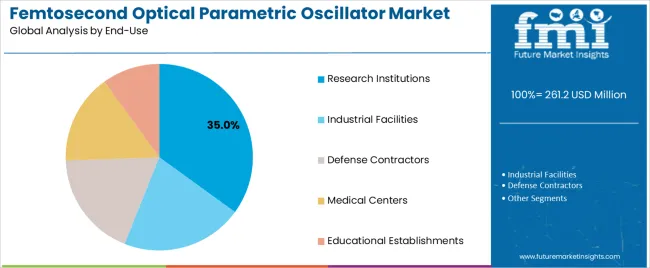
Market Context:Research institutions dominate the market, holding a 35% share, as they represent the primary demand source for femtosecond optical parametric oscillator technology in scientific applications and experimental standardization.
Business Model Advantages: Research Institutions provide direct market demand for advanced laser systems, driving innovation development and precision optimization while maintaining quality control and research excellence requirements.
Operational Benefits: Research Institution applications include experimental precision, measurement accuracy, and quality assurance that drive consistent demand for laser systems while providing access to latest optical technologies.
| Category | Factor | Impact | Why It Matters |
|---|---|---|---|
| Driver | Scientific research expansion & laboratory modernization (advanced spectroscopy, materials research) | ★★★★★ | Growing photonics market requires precision laser systems with enhanced spectral capabilities and measurement properties proven effective across research applications. |
| Driver | Technology advancement & precision requirements (ultrafast optics, spectral resolution) | ★★★★★ | Transforms laser requirements from "basic sources" to "precision instruments"; operators that offer quality systems and measurement features gain competitive advantage. |
| Driver | Industrial applications growth & materials processing (semiconductor manufacturing, medical devices) | ★★★★☆ | Advanced manufacturing needs sophisticated, high-precision lasers; demand for specialized and superior laser solutions expanding addressable market. |
| Restraint | High system costs & capital constraints (especially for smaller research facilities) | ★★★★☆ | Smaller laboratory operators defer laser upgrades; increases price sensitivity and slows premium system adoption in cost-conscious markets. |
| Restraint | Alternative laser technology competition (fiber lasers, solid-state alternatives) | ★★★☆☆ | Standard laser alternatives offer established supply chains and lower costs, potentially limiting femtosecond oscillator adoption in traditional applications. |
| Trend | Spectral technology integration & performance enhancement (wavelength control, pulse optimization) | ★★★★★ | Advanced spectral properties, precision optimization, and measurement analytics transform operations; technology integration and performance enhancement become core value propositions. |
| Trend | Automation & intelligent control systems (software integration, remote monitoring) | ★★★★☆ | Automated systems for specific research and applications; intelligent control and targeted measurement capabilities drive competition toward automation solutions. |
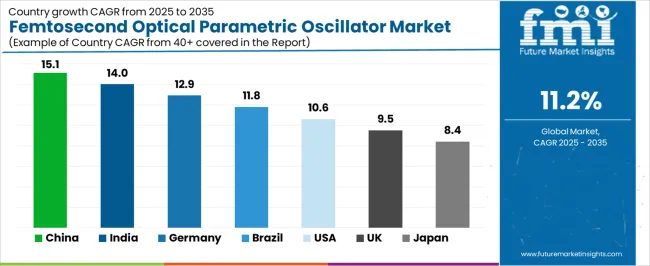
The femtosecond optical parametric oscillator market demonstrates varied regional dynamics with Growth Leaders including China (15.1% growth rate) and India (14.0% growth rate) driving expansion through research development initiatives and photonics industry modernization. Steady Performers encompass Germany (12.9% growth rate), Brazil (11.8% growth rate), and developed regions, benefiting from established research industries and precision laser adoption. Mature Markets feature United States (10.6% growth rate), United Kingdom (9.5% growth rate), and Japan (8.4% growth rate), where technology advancement and research standardization requirements support consistent growth patterns.
Regional synthesis reveals East Asian markets leading adoption through research expansion and photonics development, while North American countries maintain steady expansion supported by laser technology advancement and precision standardization requirements. European markets show strong growth driven by research applications and quality integration trends.
| Region/Country | 2025 to 2035 Growth | How to win | What to watch out |
|---|---|---|---|
| China | 15.1% | Focus on research institution partnerships | Technology transfer restrictions; local competition |
| India | 14.0% | Lead with cost-effective precision systems | Import regulations; infrastructure barriers |
| Germany | 12.9% | Provide premium precision laser systems | Over-regulation; lengthy certification processes |
| Brazil | 11.8% | Offer research-oriented solutions | Currency fluctuations; import duties |
| United States | 10.6% | Push advanced technology integration | Compliance costs; scaling challenges |
| United Kingdom | 9.5% | Focus on research excellence applications | Economic impacts; research funding constraints |
| Japan | 8.4% | Emphasize precision manufacturing | Traditional preferences; adoption rates |
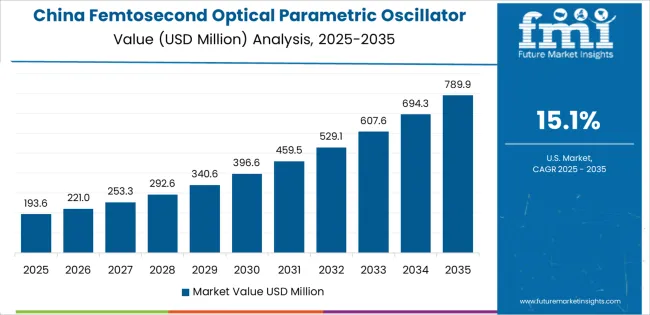
China establishes fastest market growth through aggressive research development programs and comprehensive photonics industry expansion, integrating advanced femtosecond laser systems as standard components in university facilities and research installations. The country's 15.1% growth rate reflects government initiatives promoting research infrastructure and domestic laser capabilities that mandate the use of precision optical systems in laboratory and industrial facilities. Growth concentrates in major research hubs, including Beijing, Shanghai, and Shenzhen, where technology development showcases integrated laser systems that appeal to research operators seeking spectral optimization capabilities and measurement applications.
Chinese manufacturers are developing cost-effective laser solutions that combine domestic production advantages with advanced optical features, including enhanced wavelength control and improved spectral capabilities. Distribution channels through research suppliers and photonics distributors expand market access, while government support for technology development supports adoption across diverse research and industrial segments.
Strategic Market Indicators:
In Mumbai, Delhi, and Bangalore, research facilities and industrial operators are implementing precision femtosecond laser systems as standard equipment for spectroscopy and measurement optimization applications, driven by increasing government research investment and technology modernization programs that emphasize the importance of advanced optical capabilities. The market holds a 14.0% growth rate, supported by government research initiatives and development programs that promote precision laser systems for laboratory and industrial facilities. Indian operators are adopting laser systems that provide consistent spectral performance and measurement features, particularly appealing in urban regions where research precision and operational excellence represent critical business requirements.
Market expansion benefits from growing research capabilities and international technology partnerships that enable domestic development of precision laser systems for scientific and industrial applications. Technology adoption follows patterns established in research equipment, where reliability and precision drive procurement decisions and operational deployment.
Market Intelligence Brief:
Advanced research market in Germany demonstrates sophisticated femtosecond laser deployment with documented measurement effectiveness in university applications and industrial facilities through integration with existing research systems and laboratory infrastructure. The country leverages engineering expertise in optics and precision systems integration to maintain a 12.9% growth rate. Research centers, including Bavaria, Baden-Württemberg, and North Rhine-Westphalia, showcase premium installations where laser systems integrate with comprehensive measurement platforms and facility management systems to optimize research outcomes and operational effectiveness.
German manufacturers prioritize system quality and EU compliance in laser development, creating demand for premium systems with advanced features, including facility integration and precision measurement systems. The market benefits from established research infrastructure and a willingness to invest in advanced laser technologies that provide long-term operational benefits and compliance with international research standards.
Market Intelligence Brief:
Femtosecond optical parametric oscillator market expansion in Brazil benefits from diverse research demand, including technology modernization in São Paulo and Rio de Janeiro, laboratory facility upgrades, and government research programs that increasingly incorporate precision laser solutions for scientific applications. The country maintains a 11.8% growth rate, driven by rising research activity and increasing recognition of advanced laser benefits, including precise spectral control and enhanced measurement effectiveness.
Market dynamics focus on cost-effective laser solutions that balance precision performance with affordability considerations important to Brazilian research operators. Growing technology industrialization creates continued demand for modern laser systems in new research infrastructure and facility modernization projects.
Strategic Market Considerations:
United States establishes market leadership through comprehensive research programs and advanced photonics infrastructure development, integrating femtosecond laser systems across university and industrial applications. The country's 10.6% growth rate reflects established research industry relationships and mature laser technology adoption that supports widespread use of precision optical systems in laboratory and industrial facilities. Growth concentrates in major research centers, including California, Massachusetts, and New York, where laser technology showcases mature deployment that appeals to research operators seeking proven spectral capabilities and measurement efficiency applications.
American research providers leverage established distribution networks and comprehensive technical support capabilities, including calibration programs and training support that create customer relationships and operational advantages. The market benefits from mature regulatory standards and research requirements that mandate laser system use while supporting technology advancement and measurement optimization.
Market Intelligence Brief:
United Kingdom's research market demonstrates integrated femtosecond laser deployment with documented measurement effectiveness in university applications and industrial facilities through integration with existing research systems and laboratory infrastructure. The country maintains a 9.5% growth rate, supported by research excellence programs and measurement effectiveness requirements that promote precision laser systems for scientific applications. Laboratory facilities across England, Scotland, and Wales showcase systematic installations where laser systems integrate with comprehensive research platforms to optimize measurement outcomes and operational results.
UK research providers prioritize system reliability and industry compatibility in laser procurement, creating demand for validated systems with proven measurement features, including quality monitoring integration and precision spectral systems. The market benefits from established research infrastructure and excellence requirements that support laser technology adoption and measurement effectiveness.
Market Intelligence Brief:
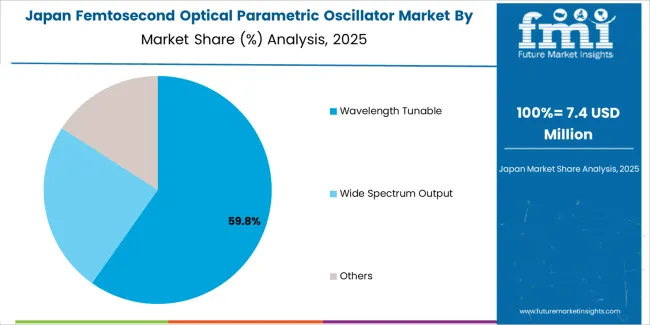
Japan's market growth benefits from precision research demand, including advanced laboratory facilities in Tokyo and Osaka, quality integration, and measurement enhancement programs that increasingly incorporate laser solutions for spectral applications. The country maintains an 8.4% growth rate, driven by photonics technology advancement and increasing recognition of precision laser benefits, including accurate spectral control and enhanced measurement outcomes.
Market dynamics focus on high-precision laser solutions that meet Japanese quality standards and measurement effectiveness requirements important to research operators. Advanced photonics technology adoption creates continued demand for sophisticated laser systems in laboratory facility infrastructure and research modernization projects.
Strategic Market Considerations:
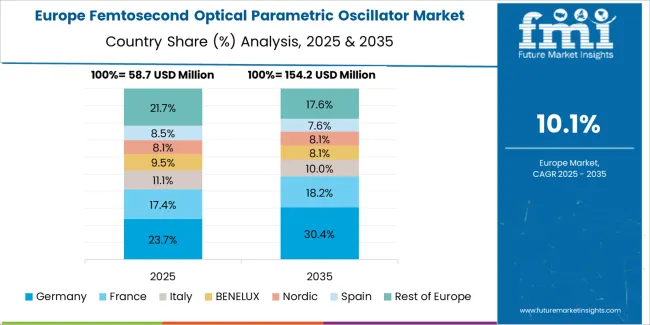
The European femtosecond optical parametric oscillator market is projected to grow from USD 58.7 million in 2025 to USD 169.4 million by 2035, registering a CAGR of 11.2% over the forecast period. Germany is expected to maintain its leadership position with a 42.1% market share in 2025, supported by its advanced research infrastructure and major photonics centers.
United Kingdom follows with a 26.3% share in 2025, driven by comprehensive research programs and scientific excellence development initiatives. France holds a 16.8% share through specialized optical applications and research compliance requirements. Italy commands a 9.2% share, while Spain accounts for 3.8% in 2025. The rest of Europe region is anticipated to gain momentum, expanding its collective share from 1.8% to 2.4% by 2035, attributed to increasing research adoption in Nordic countries and emerging photonics facilities implementing technology modernization programs.
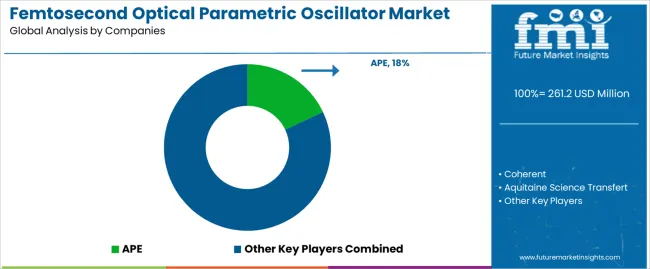
| Stakeholder | What they actually control | Typical strengths | Typical blind spots |
|---|---|---|---|
| Global brands | Distribution reach, broad product catalogs, brand recognition | Wide availability, proven quality, multi-region support | Product refresh cycles; customer dependency on brand validation |
| Technology innovators | Optical R&D; advanced laser technologies; enhanced spectral properties | Latest technologies first; attractive ROI on precision effectiveness | Service density outside core regions; scaling complexity |
| Regional specialists | Local compliance, fast delivery, nearby customer support | "Close to customer" support; pragmatic pricing; local regulations | Technology gaps; talent retention in customer service |
| Full-service providers | Laser programs, calibration services, system management | Lowest operational risk; comprehensive support | Service costs if overpromised; technology obsolescence |
| Niche specialists | Specialized applications, custom systems, research services | Win premium applications; flexible configurations | Scalability limitations; narrow market focus |
Key Players in the Femtosecond Optical Parametric Oscillator Market
| Item | Value |
|---|---|
| Quantitative Units (2025) | USD 261.1 million |
| Output Type | Wavelength Tunable, Wide Spectrum, Others |
| Application | Nonlinear Optics, Raman Spectroscopy, Lidar, Others |
| End Use | Research Institutions, Industrial Facilities, Defense Contractors, Medical Centers, Educational Establishments |
| Regions Covered | North America, Latin America, Western Europe, Eastern Europe, East Asia, South Asia Pacific, Middle East & Africa |
| Countries Covered | China, India, Germany, Brazil, United States, United Kingdom, Japan, Canada, France, Australia, and 25+ additional countries |
| Key Companies Profiled | APE, Coherent, Aquitaine Science Transfert, Newport, ETSC Technologies, Daheng New Epoch, Elliot Scientific, Light Conversion, Radiantis |
| Additional Attributes | Dollar sales by output type and application categories, regional adoption trends across East Asia, North America, and Western Europe, competitive landscape with laser manufacturers and photonics suppliers, research operator preferences for laser effectiveness and precision measurement, integration with research platforms and spectral management systems, innovations in optical technology and laser enhancement, and development of advanced laser solutions with enhanced performance and measurement optimization capabilities. |
The global femtosecond optical parametric oscillator market is estimated to be valued at USD 261.2 million in 2025.
The market size for the femtosecond optical parametric oscillator market is projected to reach USD 755.1 million by 2035.
The femtosecond optical parametric oscillator market is expected to grow at a 11.2% CAGR between 2025 and 2035.
The key product types in femtosecond optical parametric oscillator market are wavelength tunable , wide spectrum output and others.
In terms of application, nonlinear optics segment to command 57.0% share in the femtosecond optical parametric oscillator market in 2025.






Full Research Suite comprises of:
Market outlook & trends analysis
Interviews & case studies
Strategic recommendations
Vendor profiles & capabilities analysis
5-year forecasts
8 regions and 60+ country-level data splits
Market segment data splits
12 months of continuous data updates
DELIVERED AS:
PDF EXCEL ONLINE
Excimer and Femtosecond Ophthalmic Lasers Market Size and Share Forecast Outlook 2025 to 2035
Optical Extinction Analyzer Market Size and Share Forecast Outlook 2025 to 2035
Optical Character Recognition Market Forecast and Outlook 2025 to 2035
Optical Satellite Market Size and Share Forecast Outlook 2025 to 2035
Optical Imaging Market Size and Share Forecast Outlook 2025 to 2035
Optical Whitening Agents Market Size and Share Forecast Outlook 2025 to 2035
Optical Fingerprint Collector Market Size and Share Forecast Outlook 2025 to 2035
Optical Lens Materials Market Size and Share Forecast Outlook 2025 to 2035
Optical Microscope Market Size and Share Forecast Outlook 2025 to 2035
Optical Component Tester Market Size and Share Forecast Outlook 2025 to 2035
Optical EMI Shielding Adapters Market Size and Share Forecast Outlook 2025 to 2035
Optical Connector Polishing Films Market Size and Share Forecast Outlook 2025 to 2035
Optical Transmitter Market Size and Share Forecast Outlook 2025 to 2035
Optical Telephoto Lens Market Size and Share Forecast Outlook 2025 to 2035
Optical Lattice Clock Market Size and Share Forecast Outlook 2025 to 2035
Optical Grade Lithium Tantalate Wafers Market Size and Share Forecast Outlook 2025 to 2035
Optical Grade LiTaO3 Crystal Substrate Market Size and Share Forecast Outlook 2025 to 2035
Optical Brighteners Market Size and Share Forecast Outlook 2025 to 2035
Optical Liquid Level Sensor Market Size and Share Forecast Outlook 2025 to 2035
Optical Fiber Market Size and Share Forecast Outlook 2025 to 2035

Thank you!
You will receive an email from our Business Development Manager. Please be sure to check your SPAM/JUNK folder too.
Chat With
MaRIA